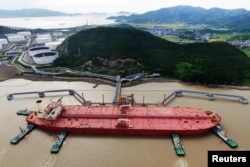As US sanctions loom, Iran’s oil exports have sharply declined by at least 800 thousand barrels per day (b/d) according to reports, but its production level declined only by about 350 thousand b/d, which show the country is storing a huge amount of unsold oil in on/offshore facilities.
Before President Donald Trump’s withdrawal from the Iran nuclear deal, Iran had boosted exports in 2017 to 2.1 million b/d of crude oil and 400,000 b/d gas condensate.
Reuters reported on October 9 that in the first week of October, exports took another sharp downturn, reaching a low of 1.1 million barrels a day.
U.S. sanctions not only drive customers away, but also impede oil shipments, by inhibiting non-Iranian tankers and their insurance companies from doing business with Iran. This is why if Tehran wants to still ship oil to willing buyers, it would have to rely on its own tanker fleet.
According to official statistics of the National Iranian Oil Tanker Company (NIOT), the country’s tanker fleet capacity is 14.1 million tons (102 million barrels). International organizations put the capacity volume at 98 million barrels.
During the last round of sanctions (2012-2015), the country’s oil exports (including gas condensate) almost halved gradually, as U.S. and international sanctions were being applied step-by-step - at about 20 percent reduction every six months.
The new round of reimposed sanctions, expected to be implemented on November 4, have already halved Iran’s exports and some reports say it go to as low as 1 mb/d in November or about 40% of average export volume in 2017.
During the last round of sanctions, Iran used its huge tanker fleet both for storing and shipment of crude oil and used domestic insurance coverage for tankers and cargo. The country is now returning to the same tactic. Currently, Iran’s Kish P&I Club as well as “Bimeh Iran” insure the oil cargoes and reportedly the majority of Iran’s oil is transported by its own fleet.
Based on Iran’s fleet capacity, it seems the country can handle all its oil shipments, because transporting oil cargoes to its farthest markets takes about a month and a half of its fleet time. Even if it sells 50 million barrels a month, its 100-million-barrel fleet capacity would be more than enough – releasing some tanker capacity for storing oil.
In 2012, Iran aimed at boosting onshore oil storage capacity to 100 million barrels.
The country hasn’t completed construction of new onshore storage facilities with 8 million barrels capacity after several years, while it inked a new agreement with local companies last month to start construction of further storage facilities with 10 million barrels capacity.
Iran has also other options: closing oil wells and storing oil abroad. The first choice is impossible for ultra-light oil (gas condensate) as it is produced from gas fields and shutting down gas fields is impossible for the country due to its vital domestic gas demand. Iran produces more than 600 thousand b/d of gas condensate, half of which is exported.
Reuters quoted Chinese media on October 8 that a vessel carrying 2 million barrels of Iranian oil discharged the crude into a bonded storage tank at the port of Dalian in northeast China. During last round of sanctions, Iran had stored 10 million barrels in Chinese facilities and all of that was sold after sanctions were scrapped in January 2016.
It is not clear if China would provide a large storage capacity to Iran, in the light of its trade tensions with the United States.







